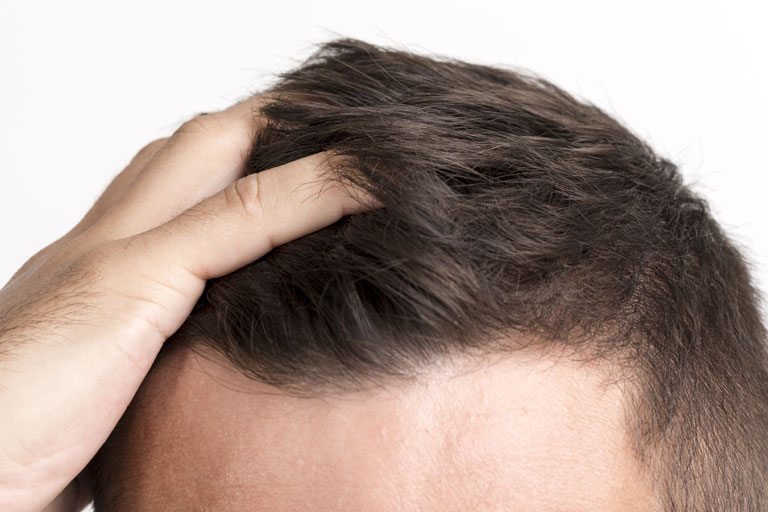Hair loss and having a balding head refer to the lack of hair on the head. Approximately 25% of all men experience some form of hair loss by the age of 30. At the age of 60, hair loss occurs in two-thirds of all men.
Baldness is usually seen when the hair in the temple region begins to thin and disappear and the pits and the hairline on the forehead begin to recede. It is also common for the hair to be sparse on the crown of the head and also on the entire head. The hairline usually starts to recede in men in their 20s, but there are many cases where hair loss starts early in the teens.
This is due to a hormone called DHT (dihydrotestosterone). DHT is a hormone associated with sexuality and the amount of hair on the head and body. DHT also affects the prostate. The process by which testosterone turns into dihydrotestosterone is still not fully understood. DHT causes hair follicles to shrink and eventually disappear. This means that the hair shaft growing in the hair follicle first becomes thinner and shorter and then resembles a colorless “baby hair” and eventually stops growing altogether.
There are many causes of baldness; the most important factor is genetic inheritance. A person with many bald men in his family is more at risk of hair loss even if the person’s baldness is not certain. There is no guarantee that someone whose family is completely bald or has hardly any bald men in their family will have hair loss, but it does reduce the likelihood.
Other factors include illness, liver-related disorders, and stress. It is not uncommon for things like childbirth, major surgeries, poisoning, and severe stress to cause hair loss.
Hair loss pattern is indicated in seven steps on the Norwood Scale.
Hair Loss in Women
Although it is rarer for a woman to lose her hair and become bald, it is not entirely unusual. It can be more difficult for a woman to suffer from hair loss than a man as it is less common and less socially accepted. A woman may be losing her hair because of too little nutrition/malnutrition, something wrong with the scalp, or hormonal imbalance, you may be very stressed or even depressed. Female hair loss is also common during pregnancy and menopause.
Although the hair on the entire scalp of women gets thinner and loses all, men often lose their hair in their temple region and/or on the top of their heads.
If you think you have lost more hair than it should be, it might be a good idea to consult a doctor. There is a disease called Alopecia Areata that attacks and dilutes the white blood cells of the hair.
What is Male Pattern Hair Loss?
While most men begin to lose their hair at the age of 17-18, others do not lose their hair until their 40s. The first thing that happens is that the hairline on the forehead starts receding upwards and starts creating a gap in the temples. Then a small round spot forms on the top of the head. It grows in size and eventually your head becomes all hairless. Men almost never lose the sides of their hair.
In addition to the hair loss, the quality of the remaining hair gradually deteriorates. Hair becomes thinner, grows more slowly and sticks to the head. The hair cells become lifeless because they can no longer be strong and produce strong hairs.
Causes of Male Pattern Hair Loss
Male pattern hair loss is caused by 95 percent of hereditary factors. The most common form of hair loss in men is androgenic alopecia caused by dihydrotestosterone hormone (DHT). This type of hair loss is normally limited to a certain part of the scalp (usually the front part of the head) and the head area. The reason why not all hair follicles are affected is that some are not sensitive to DHT. During a transplant, these hair follicles are placed in the balding area and the follicles retain their qualities and grow longer without being affected by DHT. This difference is due to how much testosterone (male sex hormone) breaks down into the scalp and forms dihydrotestosterone, DHT. Men with high testosterone conversion experience more aggressive hair loss and their hair thinning faster.
Norwood Scale
Hair loss varies from person to person. For that reason, Dr. O’Tar Norwood developed the Norwood scale to measure degrees of hair loss in men. By using this rating and looking at different categories, you can get indicators of how much hair transplantation needs to be done. For example:
Grade 1: The patient does not have a lot of hair loss. Hair transplantation is not recommended in this case.
Grade 2: Male hair loss usually starts at the temples. This may take a couple of years. When hair loss reaches a critical stage, hair transplant is often recommended.
Grade 3: At this stage, hair loss continues for several years more. Hair transplantation is often recommended.
Grade 4: Hair loss on the temples and head (and the so-called pits) is characteristic of this degree. Hair transplantation is mostly decided here.
5th and 6th Grades: Hair loss now reaches a critical stage both at the temples and on the head. Hair transplantation is a very common decision here.
7th Degree: Hair transplantation is a logical solution for many men at this stage. However, the deficiency in the donor area means that only the hairline can be improved and part of the head will be exposed.
Female Pattern Hair Loss
It is often easier to treat a bald woman than a man who has the same problem. However, the causes of female hair loss are much more complex than men. There are significantly more factors affecting hair loss and in addition to this, there are often several factors at the same time.
A woman rarely loses all of her hair and any part of her head becomes completely exposed. The typical pattern seen in women is that the entire head has a more or less evenly distributed hair thinning feature. The hairline recedes above the forehead and many women may experience thinning at the temples.
Quality also varies greatly. The hairs become thinner, flattened, and difficult to control. Generally, the hair becomes straight and weak, and especially the head hair grows much more slowly. The problematic thing many people face is that styling hair becomes more difficult and the hair does not tolerate styling products as before.
Causes of Hair Loss in Women
Female hair loss is usually related to hormones, genes and age. Other causes may be, for example, iron and vitamin deficiency, medications and metabolic problems. New mothers may sometimes even lose more hair than that is considered normal. Stress can also cause hair loss.
Women have very little testosterone in their bodies compared to men, but women are much more sensitive. Too little DHT on the scalp of women has a great effect on growing hair. Also, women have a variety of hormones that increase and decrease both in the short and long term. Things like birth control pills, menstruation, iron deficiency, pregnancy and menopause can affect hair loss. Often, the thyroid gland can register the growth of hair cells and affect growth, causing thinning or hair loss.
Ludwig Scale
Women’s hair loss normally affects a larger area and is more pronounced than men’s. Despite this, female hair loss may be related to the same factors as men’s. Women also have a scale to rate and see the frequency of the amount of hair they have lost to decide which treatment can be done. That is called “Ludwig Scale”.
If you are facing this problem, a very experienced team will be waiting for you to solve your problems and help you in the best way possible at Mediface Surgical Center in Antalya, Turkey. All you need to do is give them a call, book an appointment and get all the information you need in a consultation with our team.






